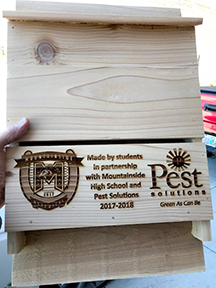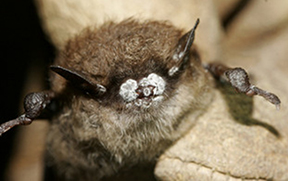 |
Previous Issues |
| Cedar Mill Community Website |
|
Search the Cedar Mill News: Search the Cedar Mill News
|
About The Cedar Mill News |
|
|||||||
| Volume 16, Issue 8 | August 2018 |
||||||
Bats in our back yards!
|
|||||||
 |
| Healthy little brown bat in Mt. Aeolus Cave photo credit: Ann Froschauer/USFWS |
If you sit outside at dusk on a summer evening, you may see some flying creatures swoop by, back and forth in your view. You’ve got bats!
The small bats we see in our backyards are known as Little Brown Bats (Myotis lucifugus) or Little Brown Myotis. They have wingspans of 7-10 inches and weigh 6-8 grams. These little bats have been recorded living to 34 years in the wild. They are associated with water, from which a great many insects hatch. There are enough ponds and swales in our area to support them and keep them feeding over our lawns and gardens.
They eat insects in the 3 to 10 mm. size range…many of them pests, such as mosquitoes, flies, termites, and even wasps. It is often said that these bats will eat 1,000 insects in an hour. But that is only if they feed non-stop. In fact their stomachs fill in about 15 minutes after which they need to digest and rest. But there will be several foraging flights per night, so they eat a lot of those pests and are very beneficial to us.
They hunt prey by echolocation, producing about 200 calls per second and hearing the echo off of the insect. In spite of that capability their eyesight is almost as good as a human’s…just not so useful for night feeding on such small bites.
Little Brown Bats hibernate when the weather cools. They may establish a separate roost, called a hibernaculum, to which they might migrate south if required by the temperature. However, the proximity of warm human structures often supplies suitable temperatures without migration. If the temperature raises enough during the winter they will interrupt their torpor to feed on insects that are also taking advantage of the warm spell.
 |
A separate maternity roost is established in the spring where the females will raise the young without the males present. The males aren’t abandoning them, but leaving them the most fecund feeding areas. Later in the summer the males may rejoin the group, with all the adults leaving the choice feeding areas to the young that are still developing their skills.
People sometimes put up bat houses, hoping to concentrate the benefits of these little mammals in their neighborhoods. They should be placed high on poles, trees, or walls to keep them away from predators. They must also be oriented correctly to the sun to maintain proper temperatures. It might take years before bats discover and begin using a bat house. Or they might discover it right away, use it for years, and then abandon it.
Pest Solutions, a local pest control company that strives to be “green as can be,” collaborated with students at the new Mountainside High School to build bat houses for some of his customers in their Career Technical Education facility. Contact Pest Solutions at 503-895-2510 for more information.
Our bats are not aggressive, even the very few that contract rabies (they will simply die from the disease), but they will bite to defend themselves. That means ill or injured bats should not be handled. They often have fleas or lice that can also carry disease, so even dead bats should not be handled.
 |
| By Marvin Moriarty/USFWS - This image originates from the National Digital Library of the United States Fish and Wildlife Serviceat this pageThis tag does not indicate the copyright status of the attached work. A normal copyright tag is still required. See Commons:Licensing for more information.See Category:Images from the United States Fish and Wildlife Service., Public Domain, link. |
Many believe that the little brown bats have adapted so well to human structures that they are more numerous than they would have been without the presence of humans. This makes them one of the few beneficial animals to have prospered from the encroachment of humans into their environment.
However, they are under extremely serious threat from another source—White nose syndrome. This is a fungal infection contracted during hibernation that attacks non-furred parts of their bodies. It often covers the nose with white fuzz, giving the syndrome its name. Although humans and other animals aren’t affected, many millions of bats have died from the disease, with some areas losing 90-100% of their population. It is moving across North America from east to west. It is still concentrated in the eastern half of the country, but has jumped ahead over 1,000 miles to be confirmed in Washington. There is no known cure. Currently, the future of these remarkable creatures seems quite bleak.
To learn more about little brown bats, and other bats in our area, go to www.batsnorthwest.org.
To learn more about white nose syndrome, go to www.whitenosesyndrome.org.
![]()
Like us on Facebook for timely updates
Published monthly by Cedar Mill News LLC
Publisher/Editor:Virginia Bruce
info@cedarmillnews.com
PO Box 91061
Portland, Oregon 97291
© 2018